Introduction
Swede midge (SM), Contarinia nasturtii, (Diptera: Cecidomyiidae) is a pest of nearly all vegetable crops in the mustard family (Brassica’s: broccoli, brussels sprouts, cabbage, cauliflower, mustard greens, kale), as well as the agronomically valuable oilseed crop, canola. In addition, >20 weed species serve as host plants, including wild radish, shepherd’s purse, field pennycress, and yellow rocket. Swede midge is native to Europe, and was first detected in North America in Toronto, Canada, in 2000. It spread to New York in 2004, and was recently found in Minnesota in 2016.
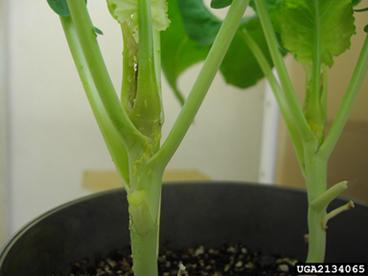
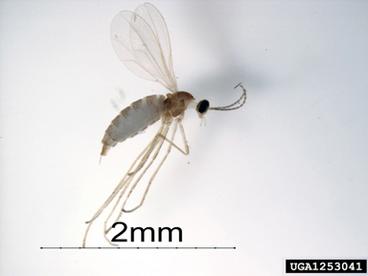
Biology
Swede midge adults are light brown, approximately 2 mm long, and nearly indistinguishable from other midges except under magnification. In Michigan and New York adults emerge in early-mid spring. Eggs are extremely small (<0.5 mm), cream colored, and are laid in clusters on young, actively growing tissue of suitable host plants. Larvae are cylindrical and transparent when young, darkening to a creamy yellow when they reach their final instar, and measure 3-4 mm in length. Larvae feed in clusters until their final instar, at which time they drop off the host plant to pupate in the soil. In Michigan, there are three-five generations from May to October.
Damage
Swede midge belongs to the gall-making family Cecidomyiidae, where their feeding leads to distorted plant tissue. Damage caused by swede midge larval feeding ranges from puckered leaf tissue, scarring, to plants with blind heads. Similar symptoms may be attributed to other sources, such as nutrient deficiencies and herbicide damage; therefore the presence of larvae is needed for accurate identification.
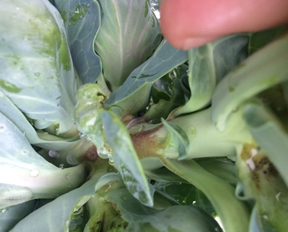
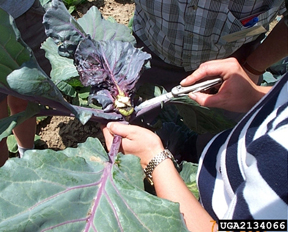
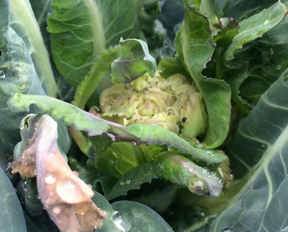
Management
Perhaps the most important thing you can do is to prevent an infestation before it happens. Communicate with your transplant supplier to ensure you are purchasing pest-free transplants, so that you are not inadvertently introducing swede midge to your farm. If transplants are infested, a transplant or soil drench containing an approved insecticide should be applied prior to planting.
Varietal Preference by Swede Midge
Researchers at the University of Guelph (Ontario, Canada), conducted trials in 2001-2003 to determine Swede midge susceptibility to cultivars of broccoli, cabbage, cauliflower and Brussels sprouts. They found broccoli to be most susceptible. Of the broccoli evaluated, ‘Paragon’, ‘Eureka’ and ‘Packman’ had the highest damage ratings in the three-year study, while ‘Triathlon’, ‘Regal’ and ‘Everest’ showed lower susceptibility and slower symptom development in at least one of three years. In the 3-year study, there was no difference in susceptibility in red and green cabbages, nor between white, red or burgundy cauliflower cultivars; ‘Jade Cross’ Brussels sprouts showed low susceptibility to swede midge.
Monitoring
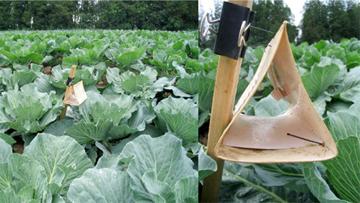
Although traps are available for monitoring the adult midge (males), it is a highly cryptic species, and adult flies may be laying eggs, with larvae causing damage, prior to adult detections in traps. Cornell researchers recommend using a white Jackson trap (Scentry Biological Inc., Billings, MT), which is a white sticky trap that contains a pheromone lure (Figure 7).Traps should be hung close to the ground and checked weekly. Previous research in NY and Canada found that 5 flies/trap can be indicative of egg-lay and larval feeding damage. If flies are detected in traps it is best to take proactive steps to minimize the risk of swede midge infestations. In addition to monitoring for adults, fields should be scouted for damage caused by the larvae. Concentrate on field edges and look for leaf puckering, scarring, or blind heads (Figures 3-5).
Cultural Control
Crop Rotation: Swede midge populations have been shown to build up in the soil, therefore crop rotation is extremely important. Cornell researchers recommend rotating out of Brassica crops for at least three years. In addition, weeds should be managed in areas close to fields. Any suitable weed host should be destroyed.
Sanitation & Crop Destruction: Although we do not have specific data for swede midge, recent studies with other, similar pests (e.g., a fruit fly, spotted wing drosophila), have shown that placing infested plant material in plastic bags (clear plastic), and exposing the bags to sunlight for 4-5 days, should generate enough heat (e.g., >120 to 140°F) inside the bags to kill swede midge. This may be reasonable for small or community gardens, particularly where SM has recently been detected. After 5-7 days, the contents of the bags can be buried or destroyed.
Composting Options: Again, without specific research for swede midge, one can still consider the benefits of composting for swede midge control. Although this approach may be less effective than bagging plant material, it is likely more feasible for larger growers. Ideally, SM infested plants should be placed in a compost pile (system) that with appropriate aeration/sunlight can reach 120-140°F. In Minnesota, if a given county (e.g., Ramsey Co.) maintains a municipal compost site, and the source farm is in the same county, the plant material can be moved to the municipal site for composting. However, in the case of Hennepin County, where such plant material is often transported to another county, not known to be infested, the municipal site cannot be used. Perhaps the best option, particularly for an invasive pest, is to compost the material on site, to minimize movement of the pest.
Chemical Control
Swede midge can be managed with preventative insecticide sprays. Trapping is an effective tool to determine when the population is emerging from the soil. When pressure is heavy in heading cole crops, seven-to-nine-day spray rotations have been effective in other states.
Information from Michigan State University, indicates that systemic neonicotinoids are a useful tool for controlling this pest. In a New York greenhouse study, foliar applications of Assail 30SG (acetamiprid) controlled larvae on cauliflower transplants using nine-day spray intervals. Field settings are more of a challenge because swede midge tends to hide from foliar applied contact insecticides on the underside of leaves near the growing tip. In New York field trials, clothianidin and thiamethoxam seed treatments offered 100 percent control of larvae for 3-5 weeks, and soil drenches of acetamiprid, imidacloprid and thiamethoxam were 100 percent effective for up to 7 weeks to control the feeding larvae.
These early season treatments can reduce the number of foliar applications required, but a field study between the University of Guelph and Cornell University indicated that supplemental foliar insecticides are especially important for mid- and later-season control of swede midge in field settings. Most pyrethroid, carbamate and organophosphate insecticides were lethal to swede midge. Insecticides including lambda-cyhalothrin, permethrin, acetamiprid, chlorpyrifos and dimethoate. Bt (Bacillus thuringiensis subsp. israeliensis) caused 50 percent mortality of larvae in a lab setting, but no organic certified (OMRI-approved) materials have been found to be effective in the field. These insecticides alone were not effective in reducing populations. To effectively manage this pest, properly timed insecticide applications with rotated chemical classes, as well as control of weed hosts, will be essential to reduce population pressure.
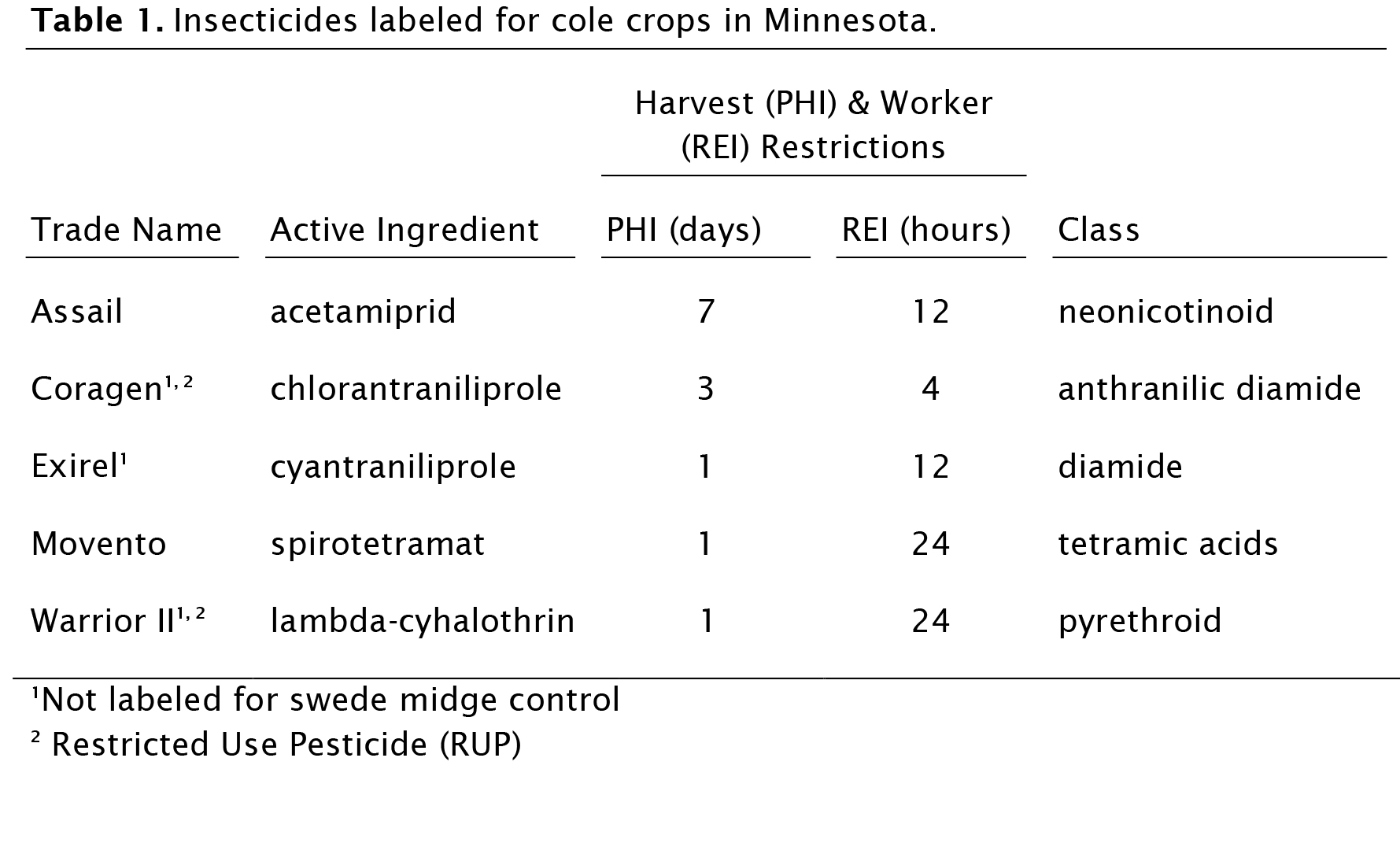
Additional Considerations
With infestations documented in 2016 and 2017 in the Twin Cities metro area, it is possible that Swede midge may be able to overwinter in MN (at least in southern MN), but the pest may also enter the state on infested transplants from other states. Trapping will continue to determine the distribution of SM in Minnesota. Research on cold hardiness is needed to better understand the ability of the pest to overwinter in the state, as well as its life cycle under MN conditions.
Growers who suspect they may have swede midge infestations should collect samples, and contact the MN Pest Alert Program, at: email: [email protected]
References
Kikkert, J., C. Hoepting, A. Shelton, M. Chen, P. Wang, Q. Wu, J.-Z. Zhao. 2017. Swede midge information center for the United States. Cornell University. Retrieved from http://web.entomology.cornell.edu/shelton/swede-midge/index.html
Minnesota Department of Agriculture. 2017. Swede Midge. Retrieved from http://www.mda.state.mn.us/plants/insects/swedemidge.aspx
Phillips, B. 2015. Swede midge, an invasive pest of cole crops, has been discovered in Michigan, presenting a new management challenge where present. Michigan State University Extension. Retrieved from http://msue.anr.msu.edu/news/swede_midge_biology_and_management
Philips, C., A. Ambourn, and L. Christianson. 2017. First detections of Swede midge (Diptera: Cecidomyiidae) in Minnesota. J. Entomol. Sci. 52(3): 297-300. Retrieved from http://www.bioone.org/doi/abs/10.18474/JES17-32.1
Stokes, B. 1953. The host plant range of the Swede midge (Contarinia nasturtii kieffer) with special reference to types of plant damage. Tidsskr. Planteavl. 59: 82-90. https://doi.org/10.1007/BF02106324
Revised April 20, 2021
W.D. Hutchison1, Suzanne Wold-Burkness1, and Angie Ambourn2
1Department of Entomology, University of Minnesota
2Minnesota Department of Agriculture